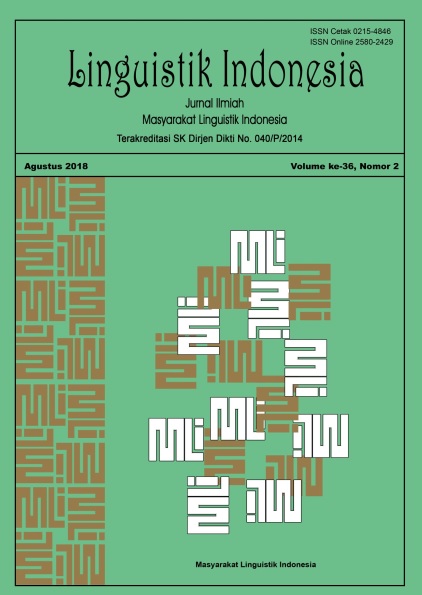MENEROPONG TIPOLOGI BAHASA-BAHASA DI PAPUA: SUATU TINJUAN SINGKAT
DOI:
https://doi.org/10.26499/li.v36i2.79Keywords:
Tanah Papua, Austronesian, non-Austronesian, grammatical features, linguistic research.Abstract
Tanah Papua, both the Indonesia provinces of Papua and West Papua, is the most diverse linguistic region that has the highest number of indigenous languages in Indonesia. Out of 760s languages in Indonesia, Tanah Papua has about 270s languages. The diversity of languages are not only about the number of languages but also about the linguistic features. Languages is Tanah Papua are divided into two major groups, which are Austronesian and non-Austronesian (known as Papuan) languages. Both major linguistic groups contribute diverse linguistic features ranging from phonological system, word, phrase, clause and sentence structures, as well as diversity of semantic and pragmatic structures. The linguistic diversity is also determined by a contact language history in the region that has been occurred for centuries, especially in the regions of Jayapura and the Bird’s Head of New Guinea. Although the region is linguistically rich, not many linguistic reseach has been doing in the region. We therefore do not have a comprehensive understanding about languages in Papua yet. The purpose of this paper is to give a brief description about grammatical features of languages in Tanah Papua.
References
Barclay, P. (2008). A Grammar of Western Dani. Lincom Europa. Munchen.
Blust, R. (1993). Austronesian sibling terms and culture history. Dalam Brijdragen tot de Taal-, Land- en Volkenkunde 149, 1. 22-76. Leiden.
Blust, R. (2009). The Austronesian languages. Camberra: Pacific Linguistics.
Clouse, D.A. (1993). Languages of western Lakes Plains. Dalam IRIAN: Buletin of Irian Jaya, Vol. XXI: 1-32.
Croft, W. (2003). Typology and universals. Cambridge: Cambridge University Press.
Dixon, R. M. W. (2010). Basic linguistic theory. Grammatical topic. Oxford: Oxford University Press.
Dol, P. (2007). A grammar of Maybrat. A language of the Bird’s Head Peninsula, Papua Province, Indonesia. Canberra: Pacific Linguistics.
Donohue, M. (2002). Tobati. Dalam J. Lynch, M. Ross & T. Crowley (eds.). Dalam The Oceania languages. New York: Curzon. 186-203.
Donohue, M. (2011). Papuan Malay of New Guinea. Melanesian influence on verb and clause structure. Dalam C. Lefebvre (ed.). Creoles, their substrates, and language typology.
-435. John Benjamins Publishing Company.
Foley, W. A. (1986). The Papuan languages of New Guinea. Cambridge: Cambridge University Press.
Foley, W. A. (2000). The languages of New Guinea. Dalam Annual Review of Anthropology, 29: 357-404.
Gombo, W. (2018). Pronominal marking system in Walak. Skripsi. Fakultas Sastra dan Budaya. Universitas Papua.
Gravelle, G. (2002). Morphosyntactic properties of Meyah word classes. Dalam Reesink (ed.). Languages of the eastern bird’s head, 109-180. Canberra: Pacific Linguistics.
Heine, B. (1997). Cognitive foundations of grammar. Oxford: Oxford University Press.
Kamholz, D. (2014). Austronesians in Papua: Diversification and change in South Halmahera-West New Guinea. Disertasi. Berkeley: University of California.
Karubaba, S.Y. (2008). Ambai Inflectional and Derivational Morphology. M.Phil. thesis.
University of Leiden.
Karubuy, T. (2011). Verbal morphology in Wamesa with reference to Windesi. Skripsi. Fakultas Sastra, Universitas Negeri Papua.
Klamer, M. (2002). Ten years of synchronic Austronesian linguistics (1991-2002). Dalam Lingua. 933-965.
Mofu, S. S. (2008). Biak morphosyntax. Doctoral thesis. Oxford: University of Oxford.
Patz, E. (1978). The case marking and role coding system of Numfor-Biak. Dalam Oceanic Linguistics, 17(2): 1414-161
Pawley & Ross. (1993). Austronesian historical linguistics and culture history. Dalam Annual Review of Anthropology, 22: 425-459.
Pawley, Andrew. (2007). The origins of early Lapita culture: The testimony of historical linguistics. Dalam Stuart Bedford, Christophe Sand and Sean P. Connaughton, (eds.), Oceanic Explorations: Lapita and Western Pacific Settlement: 17-49. Canberra: ANU E
Press.
Payne, T. (1997). Describing Morphosyntax. A guide for field linguists. Cambridge: Cambridge University Press.
Reesink, G. (2002). Languages of the Eastern Bird’s Head. Canberra: Pacific Linguistics.
Ross, M. (1996). On the genetic affiliations of the Oceanic languages of Irian Jaya. Dalam Oceanic Linguistics, 35(2): 258-271.
Ross, M. (2004). The morphosyntactic typology of Oceanic languages. Dalam Language and Linguistics 5: 491-541.
Sawaki, Y. (1998). A comparative study of Middle Yali verbal systems and those of English. Skripsi. Universitas Cenderawasih.
Sawaki, Y. (2008). Person marking systems in Dani languages. Dalam Linguistik Indonesia, 26(2): 129-149.
Sawaki, Y. (2017). A grammar of Wooi. An Austronesian language of Yapen Island, Western New Guinea. Ph.D. thesis. Australian National University.
Silzer, P.J. (1983). Ambai: An Austronesian language of Irian Jaya, Indonesia. Disertasi. ANU. Canberra.
Søgaard, A. (2005). The semantics of possession in natural language and knowledge representation. Dalam Journal of Universal Language 6: 85-115.
Van den Heuvel, W. (2006). Biak. Description of an Austronesian language of Papua. Disertasi. Vrije Universiteit.











